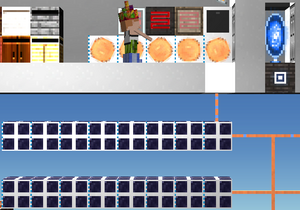Electricity: Difference between revisions
>Abcboy m (→Use) |
>McClaw No edit summary |
||
| (10 intermediate revisions by 5 users not shown) | |||
| Line 3: | Line 3: | ||
==Appearance== | ==Appearance== | ||
Electricity isn't an [[ | Electricity isn't an [[item]] that can be carried. The only time it's visible is when it's being conducted along [[Copper Wire|copper wire]] or through a conductive [[block]]. At those times, it's shown as small, cyan squares moving along the wire. | ||
==Generation== | ==Generation== | ||
| Line 9: | Line 9: | ||
Each of the above has as part of its block graphic a series of eight small "indicators" on the left side. For the steam generator or flywheel, it shows how much total power the unit can supply before it's drained. For a solar panel, it shows how much power it can generate based on conditions. | Each of the above has as part of its block graphic a series of eight small "indicators" on the left side. For the steam generator or flywheel, it shows how much total power the unit can supply before it's drained. For a solar panel, it shows how much power it can generate based on conditions. | ||
==Conductivity== | |||
To be used, electricity must be able to reach the consuming crafting surface. This requires an unbroken series of conductive materials from source to destination which can be called a conductive path. Any of the generating or storing blocks in a state to provide electricity is a source. Any electric-based crafting surface (including the electric elevator motor) being operated is a destination. If a blockhead attempts to operate a crafting surface when it has no electricity available, a red message that it needs electricity will be displayed and work will not progress until it is supplied. | |||
A conductive path can be as short as having the source and destination vertically or horizontally adjacent to each other. If they are not, conductive items or blocks must be used to bridge the gap. Electricity will not conduct along a diagonal path. | |||
Copper wire is a conductive item. It can be placed along back walls, in front of most blocks, or adjacent to another wire even if in mid-[[air]]. It will pass electricity regardless of the type of block it is placed on. | |||
Many metallic blocks are conductive and will pass electricity through them. These include [[Copper Block|copper blocks]], [[Iron Block|iron blocks]], and [[Steel Block|steel blocks]]. | |||
A [[flywheel]] will pass electricity in the same way as a conductive item. What it is actually doing is receiving electricity for storage and immediately releasing it along a new path. Other electric-based crafting surfaces will ''not'' pass electricity and are only either sources or destinations. | |||
==Use== | ==Use== | ||
The following crafting surfaces require electricity to function: | The following crafting surfaces require electricity to function: | ||
* [[Electric Stove]] (improves on the [[ | * [[Electric Stove]] (improves on the [[campfire]]) | ||
* [[Electric Kiln]] (improves on the [[kiln]]) | * [[Electric Kiln]] (improves on the [[kiln]]) | ||
* [[Electric Furnace]] (improves on the [[furnace]]) | * [[Electric Furnace]] (improves on the [[furnace]]) | ||
* [[Electric Metalwork Bench]] (improves on the [[Metalwork Bench|metalwork bench]]) | * [[Electric Metalwork Bench]] (improves on the [[Metalwork Bench|metalwork bench]]) | ||
* [[Flywheel]] (stores electricity) | * [[Flywheel]] (stores electricity) | ||
Added in [[Game updates/20140402|version 1.5]]: | |||
* [[Electric Elevator Motor]] (drives [[Elevator Shaft|elevator shafts]]) | * [[Electric Elevator Motor]] (drives [[Elevator Shaft|elevator shafts]]) | ||
These crafting surfaces craft | Added in [[Game updates/20141119|version 1.6]]: | ||
* [[Electric Press]] (improves on the [[press]]) | |||
* [[Electric Sluice]] (grinds [[gravel]] for a random [[ore]]) | |||
* [[Refinery]] (crafts advanced items, uses more electricity) | |||
These crafting surfaces craft most [[item]]s craftable at their non-electric counterparts with the same required items, but instead of using [[Crafting#Fuel|fuel]] directly, they must have a supply of electricity. | |||
==Notes== | ==Notes== | ||
Due to how they interact, using electric crafting surfaces makes more efficient use of [[fuel]]. Crafting using electric crafting surfaces takes half the time it would take to craft the same [[ | Due to how they interact, using electric crafting surfaces makes more efficient use of [[Crafting#Fuel|fuel]]. Crafting using electric crafting surfaces takes half the time it would take to craft the same [[item]]s on the non-electric versions; however, they retain the same rush cost. Some craftings may also require less materials. | ||
[[Category:Guide]] | [[Category:Guide]] | ||
[[Category:Electric]] | [[Category:Electric]] | ||
Latest revision as of 06:56, 19 April 2015

Electricity is a new useable form of energy introduced in version 1.4.
Appearance
Electricity isn't an item that can be carried. The only time it's visible is when it's being conducted along copper wire or through a conductive block. At those times, it's shown as small, cyan squares moving along the wire.
Generation
There are two sources and one storage method for electricity. A steam generator or solar panel will each create electricity. A flywheel will store electricity that comes to it and supply it to connected crafting surfaces that need it.
Each of the above has as part of its block graphic a series of eight small "indicators" on the left side. For the steam generator or flywheel, it shows how much total power the unit can supply before it's drained. For a solar panel, it shows how much power it can generate based on conditions.
Conductivity
To be used, electricity must be able to reach the consuming crafting surface. This requires an unbroken series of conductive materials from source to destination which can be called a conductive path. Any of the generating or storing blocks in a state to provide electricity is a source. Any electric-based crafting surface (including the electric elevator motor) being operated is a destination. If a blockhead attempts to operate a crafting surface when it has no electricity available, a red message that it needs electricity will be displayed and work will not progress until it is supplied.
A conductive path can be as short as having the source and destination vertically or horizontally adjacent to each other. If they are not, conductive items or blocks must be used to bridge the gap. Electricity will not conduct along a diagonal path.
Copper wire is a conductive item. It can be placed along back walls, in front of most blocks, or adjacent to another wire even if in mid-air. It will pass electricity regardless of the type of block it is placed on.
Many metallic blocks are conductive and will pass electricity through them. These include copper blocks, iron blocks, and steel blocks.
A flywheel will pass electricity in the same way as a conductive item. What it is actually doing is receiving electricity for storage and immediately releasing it along a new path. Other electric-based crafting surfaces will not pass electricity and are only either sources or destinations.
Use
The following crafting surfaces require electricity to function:
- Electric Stove (improves on the campfire)
- Electric Kiln (improves on the kiln)
- Electric Furnace (improves on the furnace)
- Electric Metalwork Bench (improves on the metalwork bench)
- Flywheel (stores electricity)
Added in version 1.5:
- Electric Elevator Motor (drives elevator shafts)
Added in version 1.6:
- Electric Press (improves on the press)
- Electric Sluice (grinds gravel for a random ore)
- Refinery (crafts advanced items, uses more electricity)
These crafting surfaces craft most items craftable at their non-electric counterparts with the same required items, but instead of using fuel directly, they must have a supply of electricity.
Notes
Due to how they interact, using electric crafting surfaces makes more efficient use of fuel. Crafting using electric crafting surfaces takes half the time it would take to craft the same items on the non-electric versions; however, they retain the same rush cost. Some craftings may also require less materials.
